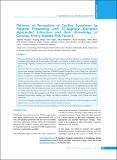Please use this identifier to cite or link to this item:
https://hdl.handle.net/20.500.14356/882| Title: | Patterns of Perception of Cardiac Symptoms by Patients Presenting with ST-Segment Elevation Myocardial Infarction and their Knowledge of Coronay Artery Disease Risk Factors |
| Authors: | Prajapati, Dipanker Sherpa, Kunjang Bogati, Amrit Manandhar, Reeju Dhungana, Murari Roka, Madhu Timalsena, Birat Krishna Acharya, Anjana Ghimire, Ashutosh Ghimire, Vijay Thapa, Kavindra Shahi, Roshani Dhungana, Suraksha Adhikari, Chandra Mani |
| Citation: | PrajapatiD., SherpaK., BogatiA., ManandharR., DhunganaM., RokaM., TimalsenaB. K., AcharyaA., GhimireA., GhimireV., ThapaK., ShahiR., DhunganaS., & AdhikariC. M. (2022). Patterns of Perception of Cardiac Symptoms by Patients Presenting with ST-Segment Elevation Myocardial Infarction and their Knowledge of Coronay Artery Disease Risk Factors . Journal of Nepal Health Research Council, 20(02), 301-309. https://doi.org/10.33314/jnhrc.v20i02.3860 |
| Issue Date: | 2022 |
| Publisher: | Nepal Health Research Council |
| Keywords: | Coronary artery disease; perception; isk factors T-elevation myocardial infarction symptoms |
| Series/Report no.: | April-June, 2022; |
| Abstract: | Abstract Background: Proper knowledge regarding Coronary Artery Disease and their risk factors is essential for the early recognition of the disease and its presentation. This study was conducted to identify pattern of clinical symptoms and knowledge regarding Coronary Artery Disease risk factors among ST-Elevation myocardial infarction (STEMI) patients. Methods: This cross-sectional, observational study was conducted among 340 ST-Elevation myocardial infarction patients in the inpatient Cardiology Department of Shahid Gangalal National Heart Centre Nepal, from November 2020 to February 2021. Baseline clinical characteristics, knowledge regarding Coronary Artery Disease risk factors, patterns of symptoms, and prehospital delay were collected and evaluated. Results: In our study, 299 (87.9%) had typical ischemic chest pain during the symptom onset, however, only 81 (23.8%) perceived chest pain as cardiac disease, and 311 (91.5%) of the patients presented to the nearby health care center within the recommended time of less than 12 hours for the reperfusion therapy of ST-Elevation myocardial infarction. Perception of symptoms as a cardiac origin and typical chest pain were not significantly associated with earlier presentation. Also, the typical chest pain was not significantly associated with the perception of the symptom as a cardiac origin. The history of Coronary Artery Disease was considered as a Coronary Artery Disease risk factor by 184(54.1%) of the study population and 137(40.3%), 132(38.8%), 110(32.4%), 105(30.9%) and 71(20.9%) considered hypertension, smoking, age, obesity, and diabetes mellitus as a Coronary Artery Disease risk factor respectively. Conclusions: Though most patients presented with typical chest pain, identification of the chest pain as a cardiac origin and the awareness of the Coronary Artery Disease risk factors was low. Keywords: Coronary artery disease; perception; risk factors; ST-elevation myocardial infarction; symptoms |
| URI: | http://103.69.126.140:8080/handle/20.500.14356/882 |
| ISSN: | Print ISSN: 1727-5482; Online ISSN: 1999-6217 |
| Appears in Collections: | Vol 20 No 02 Issue 55 April-June, 2022 |
Files in This Item:
| File | Description | Size | Format | |
|---|---|---|---|---|
| 3860-Manuscript-29671-2-10-20221103.pdf | Full Article. | 346.14 kB | Adobe PDF |  View/Open |
Items in DSpace are protected by copyright, with all rights reserved, unless otherwise indicated.
